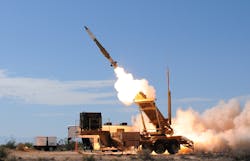Lockheed Martin to provide manufacturing, test, and planning for more PAC-3 ground-to-air missile systems
REDSTONE ARSENAL, Ala. – Ground-to-air missile experts at Lockheed Martin Corp. will provide manufacturing, test, and planning for the U.S. Army Phased Array Tracking Radar to Intercept on Target Advanced Capability-3 (Patriot PAC-3) missile under terms of a $1 billion order announced last week.
Officials of the U.S. Army Contracting Command at Redstone Arsenal, Ala., are asking the Lockheed Martin Missiles and Fire Control segment in Grand Prairie, Texas, for incidental services, hardware, facilities, equipment, and technical, planning, management, manufacturing, and testing to produce PAC-3 missiles.
This order is a modification to a $6.1 billion contract awarded to Lockheed Martin on 30 April 2020 for PAC-3 missile work.
The PAC-3 is a hit-to-kill missile designed to defeat tactical ballistic missiles, cruise missiles, and aircraft. It is a high- to medium-altitude long-range air defense missile that defends ground combat forces and high-value military equipment.
The PAC-3 missile is a high velocity interceptor that defeats incoming targets by body-to-body direct impact. PAC-3 missiles, when deployed in a Patriot battery, provide 16 PAC-3s on a Patriot launcher.
Lockheed Martin also handles the PAC-3 missile segment upgrade, which consists of the PAC-3 missile, PAC-3 missile canisters in four packs, a fire solution computer, and an enhanced launcher electronics system.
The PAC-3 missile uses a solid propellant rocket motor, aerodynamic controls, attitude control motors, and inertial guidance to navigate.
The missile flies to an intercept point specified prior to launch by its ground-based fire solution computer, which is embedded in the system's engagement control station. The PAC-3 system can update target trajectory data during missile flyout with a radio frequency uplink and downlink.
Related: Raytheon to provide Patriot missile systems and sophisticated fire-control radar to Poland
Shortly before arrival at the intercept point, the PAC-3 missile’s on board Ka-band radar seeker acquires the target, selects the optimal aim point, and guides the missile to its target.
The PAC-3's attitude control consists of small short-duration solid- propellant rocket motors in the missile forebody, and fire to refine the missile’s course to ensure the missile hits its target.
The PAC-3 MSE missile is the primary U.S. interceptor for the multinational MEADS transatlantic development program focused on the next generation of air and missile defense.
On this order Lockheed Martin will do the work in Huntsville, Ala.; Camden, Ark.; Chelmsford, Mass.; Grand Prairie and Lufkin, Texas, and should be finished by October 2024. For more information contact Lockheed Martin Missiles and Fire Control online at www.lockheedmartin.com, or the Army Contracting Command-Redstone Arsenal at https://acc.army.mil/contractingcenters/acc-rsa.
About the Author
John Keller
Editor-in-Chief
John Keller is the Editor-in-Chief, Military & Aerospace Electronics Magazine--provides extensive coverage and analysis of enabling electronics and optoelectronic technologies in military, space and commercial aviation applications. John has been a member of the Military & Aerospace Electronics staff since 1989 and chief editor since 1995.
